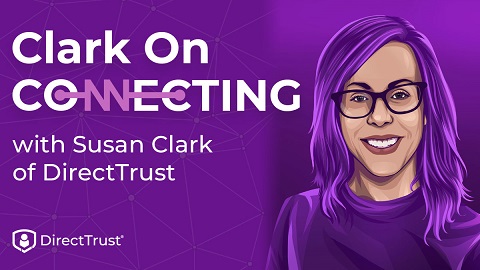 Susan Clark, Senior Director of Program Development, DirectTrust
Susan Clark, Senior Director of Program Development, DirectTrust
LinkedIn: Susan Clark
Clark on Connecting
For this month’s Clark on Connecting, I will be sharing a story that spans almost fifteen years of relationships to have made the most recent glorious “Clonnection.”
Back in the early times of Promoting Interoperability (then still known as Meaningful Use), I was working to support this program for Eskenazi Health, Indianapolis’s safety net hospital and its ambulatory providers. At that time, they were utilizing an EHR designed and built by Regenstrief Institute. In the course of my work, I engaged with them often on EHR functionality and enhancement requests. At that time, I was hyper-focused on serving the providers, staff, and patients of that organization and was only using the lens of their role as an EHR vendor. As I came to discover, Regenstrief was not just the pretty building on the other side of the parking lot but a renowned global health research leader, and creator of Logical Observation Identifiers, Names and Codes (LOINC, as appreciated by my fellow data standards nerds). This is also the same time when I had been becoming acquainted with the Indiana Health Information Exchange (IHIE) where Dr. Shaun Grannis serves as Chief Medical Information Officer as well as Vice President of Data and Analytics for Regenstrief, where he has conducted a significant amount of research on patient matching in health information exchange (HIE). In a parallel universe, I became passionately involved with federal advocacy on creating patient matching solutions via AHIMA (American Health Information Management Association). So much so that I served as the Advocacy & Policy Council Chair for two years.
Meanwhile, a couple years ago, I had the great opportunity to support ONC (Office of the National Coordinator) on a strategic planning project for scientific advancement. I had not really worked in the research world before, so it was an exciting learning experience that also led me back to Dr. Grannis as one of the subject matter experts we interviewed during that time, allowing us to reconnect and reminding him that I lived just a bit up I-65 from him.
Now, to the present day. AHIMA leads the Patient ID Now Coalition calls and my employer, DirectTrust, is a member. In my advocacy role for DirectTrust, I now attend Coalition meetings as a member representative. On a recent call, I was introduced to another researcher working on patient matching in HIE. I followed up by sending a message to offer support and asked if he knew Dr. Grannis. The researcher knew of him but did not know him personally, so I made the email introduction, to which Dr. Grannis responded and offered support almost immediately. #Clonnection
The core takeaways here from my #Clonnection principles:
- Doing something for the greater good and giving without expectation of return. I saw the value of having two great minds working on a needed solution and not risking the new project duplicating research that already exists. It is astonishing how many organizations and technology vendors match on just a couple of data elements and call that “good enough,” and we need to develop and enforce a standard for this for patient safety. I hope by having made this introduction it accelerates the research to illuminate the best technology and practice.
- Introduce yourself. I honestly do not remember exactly when I met Dr. Grannis initially. But I do find him intellectually intimidating because of his many deserved letters after his name and depth and breadth of his research. However, as I have become more involved in this topic, I engage with him regularly.
Because I assert myself to interact with really cool and smart people, I am able to facilitate innovation, advocacy, and interoperability in my own little “Clonnective” ways.

